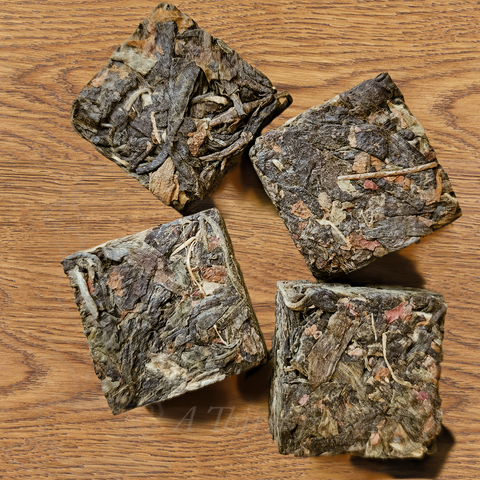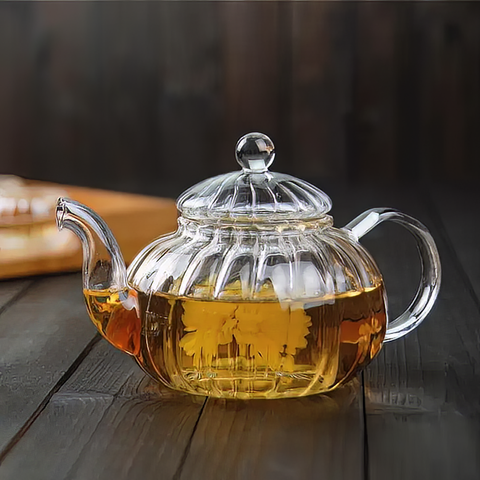Zhang Xue Lei: Prosperity
$450.00Zhang Xue Lei: Prosperity
$450.00- Gallery
- Description
- Yixing Teapot Background
- How to Clean & Prime your new Yixing Teaware
- Reviews
The wonderfull black color of this Yixing teapot is the result of a special firing technique that is called wu hui (焐灰).
Firstly, the teapot is fired once normally. It is then buried in wood or straw ash to return to the kiln for a second time. The iron particles in the clay are thus fired under a deoxygenised environment and become black.
Unlike an ash glaze, the material — iron — that colorizes the pot exists naturally in the clay, without the need for adding a glaze material. In other words, the second firing transforms the zisha clay from the reddish color into black.
Although Wu hui Yixing teapots have been in vogue in the tea community for only a few years, the technique itself is an old one that was originally used to salvage misfired Yixing clay wares. The technique has evolved to produce such a wonderful black by the merits of the diligent spirit of the kiln artisans in Yixing.
Artist: Zhuang Xue Lei, National Associate Master Industrial Artist
Pot style: Squashed Belly ( Bian-fu )
Material: Wu hui zisha
Capacity: 170 ml
Zhang Xue Lei

Often referred to as Xue Lei — an honest and big pile of snow — this young, talented and up-and-coming artist has already been well collected and has been aggressively experimenting with various form styles and clays. In 2017 at the age of 21, he received an Innovation Award at the prestigious “Yixing Centenarian New Talents Selection Awards”. His works actually show a solid traditional craftsmanship foundation with precision and elegance in addition to his creative flair. We are keeping an eye on this promising young artist and hopefully will bring more of his work online.

All Yixing teapots in our Master Artist Collection are delivered with a pull-string towel sack in a collector's box with cushions inside.
Note:
Unless otherwise stated, all Yixing teapots are new from the kiln. Please properly clean and prepare them before making tea in them. There is a proper procedure to do that which is explained in the tab "How to Clean & Prime your new Yixing Teaware" at the bottom of this page.
We try our best to represent the colors of all tea accessories, including Yixing teapots in the product photographs. However, there are many factors that we cannot control, including those that affect how the photos are rendered in your computer or mobile device. There may be interpreted discrepancies between the color as seen on this site and that of the product you receive.
Capacity: 170 ml. (5.75 fl oz.)
Origin: Yixing, China
Yixing teaware first appeared in the early Northern Song dynasty (960 to 1279 A.D.) in China and gained in popularity during the Ming dynasty (1368 to 1644 A.D.). They were made of the purple clay, zisha clay, that is said to only occur in the Yellow Dragon Cave of Dingshan town in Yixing, China. It is said in China that zisha clay is worth more than gold and teapots made of this clay are prized despite their high prices due to their advantages in brewing tea. Not only are they said to maintain the freshness of the tea for long periods of time, but they also bring out the flavor of the tea and retain the heat longer than teapots made of other materials. This makes Yixing pots especially useful in the preparation of gongfu cha (the Chinese Tea Ceremony) because it allows the tea master to ensure that the quality of the tea is the same for each participant. Zisha clay is very porous and because of this it is advisable to brew only one kind of tea in an Yixing teapot because it will absorb the tea into the clay itself. It is said that after many years of using an Yixing teapot all you have to do is add hot water to the pot in order to have a perfect cup of tea. A Chinese tea aficionado (particularly the old timers) will use the Yixing teapot not only to brew their tea, but also to drink it straight from the spout.Yixing teapots are used primarily in brewing oolong and puerh teas. The pots tend to be small, single serving size pots because these teas can be brewed numerous times. No tea collection is complete without a good Yixing tea pot!
The Yixing teapot to tea making is equivalent to, if not more critical than, the oak barrel is to wine making. So what is it specifically that makes these teapots so effective?
When properly used, an Yixing pot can bring out the maximum potential of a tea like no other teaware can. An authentic Yixing teapot, therefore, is not just a craft object, but also an essential tea tool. The material and the efficiency of the shape are two deciding factors for the utilitarian value of the Yixing pot. Well-considered ergonomics, superb spout flow, and precise crafting are basic in ALL acceptable quality Yixing pots. The neck of the lid should fit perfectly into the collar of the body. The lips of both should fit so flatly against each other that there is a vacuum pull when you try to open the lid. Leveling of the collar of the pot is instrumental in gongfu tea infusion when water is filled to the rim, and the underside of the lid neck is used to scrape the surface of the water before covering the pot for tightness.
the material
The world has yet to discover a material capable of maximizing infusion effects like the clay mined from Yixing. Whether the clay is genuine and how it is process-refined are crucial factors for deliberation. Different styles and techniques in clay refinement, manipulation and firing result in Yixing clay of various colours and finishes, and more importantly, physical structure (such as density and pores character), making it possible to render different infusion results to satisfy different requirements. Yixing clay is a big subject in itself and in its relationship with various teas.
the shape
How the hot water circulate by way of convection within the teapot is a major factor for the usability of the teapot. It is decisive in the taste coherence and texture character of the result. Heat loss, the rate of which also plays a role in the result, is also affected by the shape. The shape of the teapot is therefore related closely to how one conducts tea making and the choice of tea variety. Additionally, there is the very personal ergonomic requirements.
Strainer holes are pierced through the wall of the pot body rather than placing an additional ready-made one. This is not only aesthetically more pleasing, but also maintains the shape integrity of the interior for efficient water convection.
If you need some advice in deciding a shape to buy, there is always the classic caldron shape that is an all ‘round’ solution for most infusion conditions.
one pot one tea variety
Because of the micropores of the material, which give Yixing clay its “breathing” property and potential to render a fine infusion, taste matters of tea also very gradually build up into the pot. This is good and bad for the user. The good part is that with repeated use, the infusion itself actually improves. The bad part is that you cannot use the same pot for a different variety of tea to avoid conflicting taste substances from different tea blending together. For example, a green style tieguanyin cannot be steeped in a pot that has been used to make golden tip puer, or even a bouquet style Phoenix oolong. If you ever made such mistakes, re-prime the pot all over again, but boil it with water two times in the cleaning step instead of once. (read the paragraph below for cleaning)
Throughout the ages they have been renowned for their unique artistry and practical usage by incorporating the concepts of aesthetic beauty and natural harmony. In the Song dynasty Yixing zisha (purple clay) teapots were very simple, not at all ornate. As the centuries progressed they became more and more elaborate, decorative and elegant. As a matter of fact, the Forbidden City did not accept the Zisha teapot into its collection until the early Qing dynasty (1644 - 1911 A.D.) By that time the Zisha teapot had been elevated to an artistic form, and potters and scholars worked together to make beautiful, ornate pot styles.
The care, cleaning and priming of any and all Yixing teaware is essential. By its very nature Yixing clay is very porous and will absorb not only the tea that is infused within, but also any aromas/odors nearby. Consequently, an Yixing teapot should be stored away from any such odors and should only be used for one particular type of tea. For example, to brew an oolong tea in your Yixing teapot followed by a puer tea will only muddy the flavors of the tea.
The cleaning and priming of all Yixing teaware is a multiple step process. The process is essential and time-consuming but not difficult. Absolutely NO cleaning agents of any kind should be used.
Cleaning:
- Firstly, rinse the teapot inside and out with fresh water. Next, rinse the pot again and submerge it in a deep pan/pot of clean fresh water and leave it to soak overnight.
- Rinse the pot again and submerge it in clean fresh water in the deep pan/pot on the stove. Bring the water to a full boil, then reduce the heat to a medium boil and boil for five minutes.
- Drain the water and rinse the pot with clean fresh water once again.
Priming:
- Submerge the teapot in fresh clean water in a deep pan/pot to cover and bring to a boil. Remove from the heat once the water comes to a boil. (Do not drain.)
- Immediately add to the hot water the tea you wish to use with this particular pot and cover as if you were making a pot of tea. Leave the teapot to steep overnight in this pan of hot water with tea.
- Drain and rinse the teapot in clean fresh water and let it air dry with the lid open.
- Your Yixing teapot is now primed and ready for your first pot of tea.
Seasoning:
- The pot is seasoned with every use.
Daily Cleaning:
- Because Yixing clay is so porous you must NEVER use detergent or any other cleaning products to clean the pot.
- After each use simply empty the leaves and give the pot a good swirl of hot water.
- Let the pot air dry with the lid off, making sure to not let it come in contact with any strong odors such as cooking fumes, cigarette smoke or perfume.




































